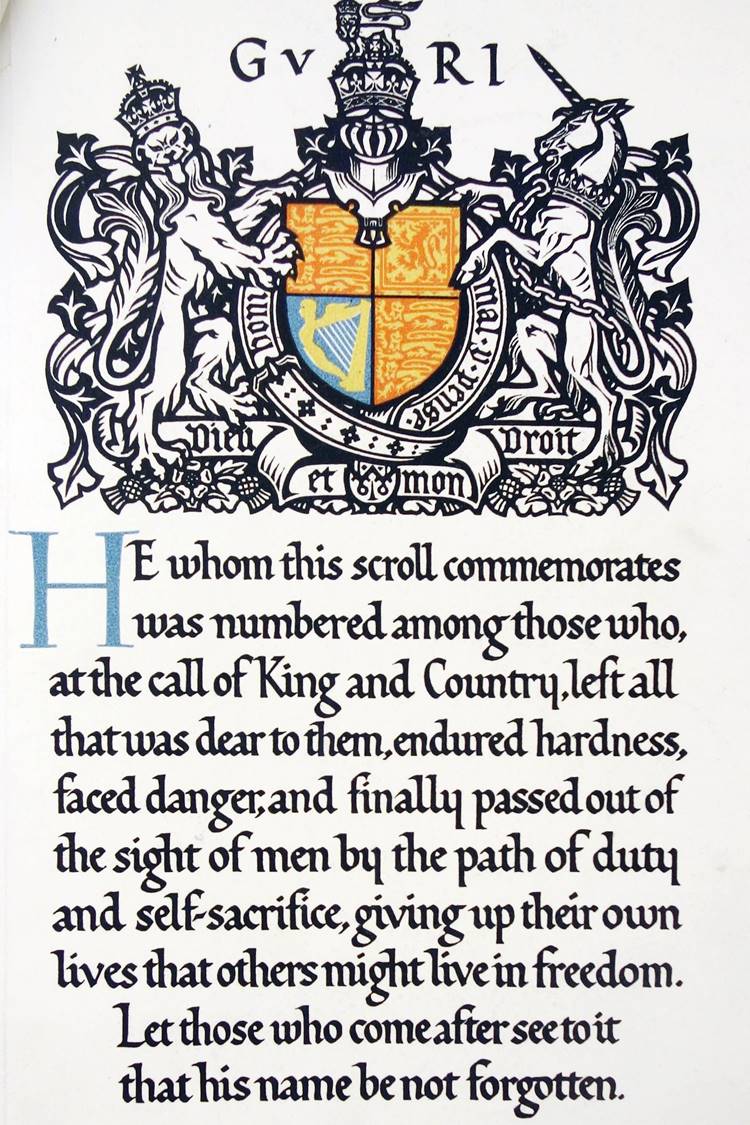This article on the First World War memorial scroll is one of my guides to help you research a soldier who served in the British Army during the war. I have also written an article about the memorial plaque which is often found with the scroll and other guides to help you:
The First World War Memorial Scroll
The First World War memorial scroll was sent to the next-of-kin of soldiers who had died during the First World War and has become closely associated with the memorial plaque. The creation of the memorial scroll was announced in The Times on 18 October 1917:
In addition to a plaque, a scroll with a suitable inscription will be given. This is being designed at present moment and it is hoped that it will be possible to put printing in hand in less than a fortnight.
Despite the announcement that the production of the scrolls would start in November, the exact wording of the scroll was still being debated in January 1918. Well-known writers of the day, including Rudyard Kipling, were consulted before the final wording was decided on.
The First World War memorial scroll was 27cm x 17cm in size and printed on high-quality paper. Unfortunately, due to being produced on paper, many scrolls have failed to survive to the present day. A large number have only survived due to the practice of displaying them in the family home, with the frame offering protection over the last hundred years. At the top of the scroll is the Royal Coat of Arms, with GV RI standing for King George V. Immediately below the crest, is the following inscription:
He whom this scroll commemorates was numbered among those who, at the call of King and Country, left all that was dear to them, endured hardness, faced danger and finally passed out of the sight of men by the path of duty and self-sacrifice, giving up their own lives that others may live in freedom. Let those who come after see to it that his name is not forgotten.
Beneath the inscription is found the rank, name and unit of the deceased soldier written in ink. If a soldier won a gallantry award,e.g. the military medal, then post-nominal letters can also be found on the scroll. The passages below are taken from a pamphlet Memorial Plaque and Scroll: Regulations Regarding Issue and describe in detail what exactly went on a scroll:
Ranks. The highest acting or temporary rank held continuously for 6 months will be inscribed, if such rank is higher than that held at date of death.
Units. The unit to which the deceased officially belonged at the time of his death will be inscribed. Exceptions. (a) Labour Corps. – When a man previously belonged to a fighting unit and was transferred to the Labour Corps, the original unit will be inscribed. (b) Training Reserve – In the case of a soldier who died whilst belonging to the Training Reserve, if he previously belonged to a Corps before transfer to the Training Reserve, such Corps will be inscribed.
(iii) General Officers and Staff Officers. (a) The appointment held by a General Officer at date of death will be inscribed. (b) In the case of a Staff Officer below the rank of Brigadier General, the regiment to which he belonged will be inscribed.
(iv) Decorations. Only those decorations, signified by officially recognized abbreviations (V.C., D.S.O., M.C., D.C.M., &c.), [Victoria Cross, Distinguished Service Order, Military Cross, Distinguished Conduct Medal] will be inscribed. The words “and bar” will not be added. Foreign decorations will not be inscribed.
(v) Regiments. The official titles of regiments, as shown on page xxxix of the Army List, will be inscribed.
The scrolls were sent out separately from the memorial plaques in a cardboard tube. If you only have a soldier’s memorial scroll, then it can be very useful in starting your research into their service. However, if they had a common name e.g. John Smith, then there will usually be multiple possibilities on the Commonwealth War Graves Commission website.
Researching Soldiers who Lost their Lives in the First World War
You can often find out a lot of information on a soldier who died during the war and my following guides will help you:
- Soldiers Died in the Great War
- De Ruvigny’s Roll of Honour
- Bond of Sacrifice – For officers who died between August 1914 and June 1915
- First World War casualty lists
- International Red Cross prisoner of war records
- How to Order a First World War era death certificate
I would highly recommend searching the British Library’s digitized newspaper collection which is available to search on FindmyPast. The collection has the War Office Weekly Casualty Lists from August 1917 until December 1918 and a large number of local papers for the period. There are also thousands of portraits of soldiers who died during the war and accounts of their deaths in local papers. Tens of thousands of new pages are added every month. Clicking on the banner below will take you to FindmyPast which has a free trial period:

